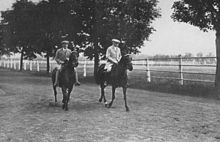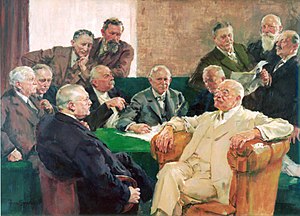Carl von Weinberg
Carl von Weinberg (born September 14, 1861 in Frankfurt am Main , † March 14, 1943 near Florence ) was a German businessman , entrepreneur, founder and socially committed citizen.
Life

Carl and his one year older brother Arthur von Weinberg came from a Jewish merchant family, the father was Bernhard Weinberg . In 1880 both were baptized Protestants. Carl completed a commercial apprenticeship and in 1882 at the age of 21, like his brother, became a partner in Leopold Cassella & Co. , which merged in 1894 with the Frankfurt aniline dye factory founded by his uncle Leo Gans and subsequently became world famous in the manufacture of synthetic dyes as Cassella Farbwerke Mainkur got.
In Niederrad he and his English wife May (Ethel Mary Villers Forbes from the house of the Irish Earls of Granard ), who was born in Plymouth in 1866, had the Villa Waldfried built in the English country house style by the architects Otto Bäppler and Aage von Kauffmann . This huge property had around 100 rooms. It provided space for the couple's important art collection, comprising over 700 objects. One year before moving in, the longed-for daughter Wera was born in 1897 († April 9, 1943 in London ), who later married Richard von Szilvinyi. Wife May von Weinberg made a name for herself as a donor in Frankfurt . A chapel was set up in the house for the Catholic May . The Niederräder chaplain Georg Nilges later celebrated the Sunday service in the house chapel . Carl von Weinberg donated a considerable amount for the new building of the church for the Niederräder parish of Mutter vom Guten Rat . The Italian Renaissance fountain ( Florentine fountain ) of the house that was destroyed in the air raids on Frankfurt am Main in World War II has been in the garden of the Nebbienschen Gartenhaus , an artists' meeting place in the Bockenheimer facility in downtown Frankfurt , since 1952 . In 1908 the family was given the title of nobility.
In 1919 Carl von Weinberg was a member of the German delegation to the Versailles peace negotiations . In 1924 he took part in the negotiations on the German reparations in London , which resulted in the Dawes Plan . In 1925 the Weinberg brothers merged Cassella to form IG Farbenindustrie AG , in which they both served as members of the supervisory and administrative boards .
Together with his brother, he gave numerous financial contributions to various institutions (including the University of Frankfurt ). In 1921, with his support, the Carl von Weinberg School named after him was built in Schwanheim. The founding of the Frankfurt Polo Club in 1913 and the polo facility also go back to his initiative. He also founded the Waldfried Stud , which became known far beyond the borders of his hometown.
His wife May died in 1937. She was buried in the vineyard chapel of the Niederräder church "Mother of the Good Council". Large parts of your estate went to this church , some parts received former Niederräder Kaplan Georg Nilges, who since 1929 pastor in the newly built Cross Church Holy in Frankfurt - Bornheim in the settlement Bornheimer Hang was. There is still a 183 × 138 cm large wooden crucifix in the anteroom of the crypt of the meditation center of the Limburg diocese . Presumably it originally came from the Alpine region of the 17th or 18th century. There it came into the possession of the von Weinberg family, as they owned a hunting lodge in Oberdrauburg in Carinthia .
persecution
After the seizure of power by the Nazis in 1933, the brothers vineyard were persecuted because of their Jewish origins. Carl von Weinberg was forced to give up his offices in the economy. Both the school and Carl-von-Weinberg-Strasse were renamed. The patronage of Buchenrodestrasse, which was named after Arthur von Weinberg's villa “Buchenrode”, and Waldfriedstrasse, named after the stud farm of the Weinberg family, were canceled.
After the November pogroms in 1938 , he had to sell his Villa Waldfried along with his important art collection to the city for a fraction of its value . The Frankfurt artist Lina von Schauroth , a close friend of the von Weinbergs, managed to bring the four glass windows she had created in the private chapel of Villa Waldfried to safety after the landlord had escaped. During the war they were kept in the Limburg Cathedral Museum and installed in the nave of the Old Nikolaikirche on Frankfurt's Römerberg in 1951 at the instigation of the Evangelical Synod . On the window “Ascending Christ” on the west side there is the dedication: “The glass windows come from the chapel in Waldfried. Carl v. Weinberg has it in memory of his wife May geb. Forbes donated. "
After his property was expropriated, Carl von Weinberg, widowed since 1937, went into exile to live with his married sister in Italy. He died on March 14, 1943 near Florence , six days before his brother Arthur died in the Theresienstadt concentration camp as a result of an operation. Carl von Weinberg was buried in the grave of his sister's family in the Chiusi mountain cemetery, who was married to Conté Paolozzi from Chiusi.
Awards
- In 1927 he was awarded an honorary doctorate from the University of Frankfurt,
- In 1928 he was awarded the silver plaque of the city of Frankfurt.
After 1945 all name changes were reversed. In addition to the Carl-von-Weinberg-Schule and the Carl-von-Weinberg-Strasse in Frankfurt's Westend , a park in Frankfurt-Niederrad with his bust on the site of the former Villa Waldfried commemorates the patron and supporter of Frankfurt.
literature
- Ernst Mack: The von Weinberg family from Frankfurt. Under the sign of the cornflower blossoms. Heimat- und Geschichtsverein Schwanheim eV, Schwanheim 2000, ISBN 3-921606-55-1
- Angela von Gans, Monika Groening: The Gans family 1350-1963. Verlag Regionalkultur, Heidelberg 2006, ISBN 978-3-89735-486-9
- Lina v. Schauroth - a Frankfurt artist. Edited by Helene v. Schauroth. Waldemar Kramer Verlag, Frankfurt am Main 1984, ISBN 3-7829-0291-2
- Hansjörg W. Vollmann: Cassella and her owners - great Frankfurt patrons . Lecture as part of the series “Patrons, Donors, Urban Culture” of the Frankfurt Community Foundation on Wednesday, January 23, 2013, 7.30 p.m., venue: Haus am Dom , Frankfurt, Bad Soden am Taunus , January 23, 2013, lecture as PDF, accessed on : January 3, 2014
- Mirco Overländer: von Weinberg Frankfurt family Persecuted, ostracized, but not forgotten. Frankfurter Neue Presse , November 9, 2013, accessed on June 21, 2015 .
Web links
- Literature by and about Carl von Weinberg in the catalog of the German National Library
- Carl von Weinberg in the Frankfurt portal from 1933 to 1945
- Carl von Weinberg School , website
- Image by May von Weinberg
- Carl von Weinberg at wollheim-memorial.de
- May von Weinberg (1866-1927) including her portrait bust by the sculptor Alexander Archipenko (1887-1967)
Individual evidence
- ^ Kai Drewes: Jewish nobility. The ennoblement of Jews in Europe in the 19th Century , Frankfurt am Main 2013, ISBN 3-593-39775-7 , p. 394, note 36.
- ↑ In memoriam May von Weinberg - b. Ethel Mary Villers Forbes from the house of the Earl of Granard Plymouth 1866 - Frankfurt / M 1937. In: Homepage. Lüder H. Niemeyer Art dealer since 1959, February 24, 2014, accessed on February 21, 2015 .
- ^ A b Hermann Gille, P. Helmut Schlegel : Catholic Holy Cross Church Frankfurt-Bornheim . Schnell und Steiner publishing house, Regensburg 2009, ISBN 978-3-7954-6808-8 .
- ↑ Lina v. Schauroth. 1984, p. 10.
| personal data | |
|---|---|
| SURNAME | Weinberg, Carl von |
| BRIEF DESCRIPTION | German industrialist and patron |
| DATE OF BIRTH | September 14, 1861 |
| PLACE OF BIRTH | Frankfurt am Main |
| DATE OF DEATH | March 14, 1943 |
| Place of death | near Florence |




